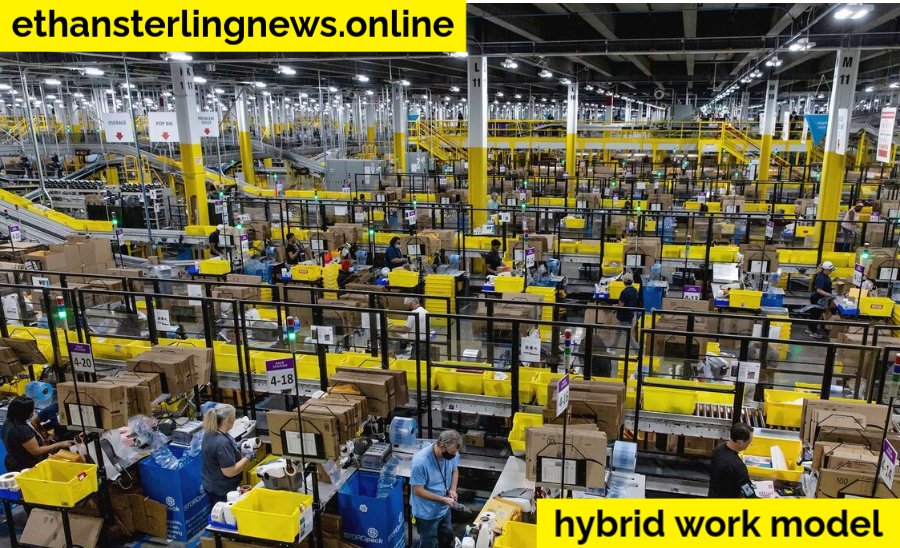Table of Contents
The workplace as we know it has changed dramatically in recent years, with the emerging as a dominant trend. As organizations navigate the post-pandemic world, the hybrid work model is no longer just an alternative to the traditional 9-to-5 office setup; it has become a strategic approach to accommodate a more flexible, inclusive, and productive work environment.
In this blog, we will explore the concept , its benefits, challenges, and its impact on employees and employers alike. We will delve into why more companies are adopting this model and how it’s shaping the future of work. is not just a trend; it’s here to stay, and understanding its nuances is crucial for any organization looking to thrive in a rapidly changing business landscape.

What Is the Hybrid Work Model?
The hybrid work model is a flexible approach that combines both in-office and remote work. It allows employees to split their time between working from a physical office and working remotely, often from home. This model is designed to offer the best of both worlds by providing employees with the flexibility to work from anywhere while still benefiting from the collaborative environment of the office.
The hybrid work model can take many forms. Some companies may require employees to come into the office on specific days, while others might allow employees to decide when they work remotely or in the office. This flexibility is one of the key reasons why the hybrid work model has gained such popularity, particularly after the COVID-19 pandemic accelerated the shift towards remote work.

Why Is the Hybrid Work Model Gaining Popularity?
The hybrid work model gained momentum during the pandemic as businesses were forced to adopt remote work to keep operations running. However, even as the world gradually returns to normal, many companies are realizing that the benefits of the far outweigh the drawbacks. Let’s explore some of the key reasons why the hybrid work model is here to stay:
- Increased Flexibility for Employees
The allows employees to have more control over their schedules, helping them achieve a better work-life balance. The freedom to work remotely on certain days reduces commuting time and allows employees to work in environments where they feel most comfortable and productive. - Higher Employee Satisfaction and Retention
Employees appreciate the autonomy that comes with the . By offering flexibility, companies can boost employee morale and satisfaction, which in turn helps reduce turnover rates. The ability to tailor one’s work environment can lead to improved job satisfaction and loyalty. - Improved Productivity
While some might assume that working remotely could lead to distractions, studies have shown that the can actually enhance productivity. Employees can focus better in their home environments, free from office interruptions, while still benefiting from in-person collaboration on office days. - Cost Savings for Employers
The hybrid work model can help companies save on operational costs. With fewer employees in the office every day, organizations can reduce expenses related to office space, utilities, and other overhead costs. - Access to a Global Talent Pool
One of the greatest advantages of the hybrid work model is the ability to hire talent from anywhere in the world. Companies are no longer restricted by geographic boundaries, which means they can tap into a diverse and global talent pool to find the best candidates for their needs.
Challenges of the Hybrid Work Model
Despite its many benefits, the hybrid work model comes with its own set of challenges. Organizations must be mindful of these challenges in order to implement the model successfully. Let’s take a closer look at some of the potential pitfalls:
- Maintaining Company Culture
One of the biggest concerns with the hybrid work model is maintaining a strong company culture. When employees are not in the office every day, it can be difficult to foster a sense of belonging and camaraderie. Employers must find ways to keep employees engaged and connected, whether they are working remotely or in the office. - Communication and Collaboration
In a hybrid work model, clear communication is crucial. Remote employees may feel isolated if they are not regularly included in important discussions or meetings. Companies need to ensure that they have the right tools and practices in place to facilitate communication and collaboration between remote and in-office teams. - Technology and Infrastructure
The hybrid work model requires robust technology and infrastructure to support remote work. This includes reliable internet connections, cloud-based collaboration tools, and secure systems to protect sensitive company data. Without the right technology in place, it can quickly become frustrating for employees. - Managing Performance and Accountability
It can be challenging for managers to monitor employee performance when teams are dispersed between the office and remote locations. Managers must adapt to the by focusing on outcomes rather than hours worked. Establishing clear expectations, regular check-ins, and performance metrics are essential for ensuring accountability in a hybrid work environment. - Work-Life Balance
While the hybrid work model offers more flexibility, it can also blur the lines between work and personal life. Some employees may struggle to switch off from work when their home is also their office. Companies must promote a healthy work-life balance by encouraging employees to set boundaries and avoid overworking.
How to Implement the Hybrid Work Model Successfully
To implement the hybrid work model effectively, organizations must carefully plan and consider the needs of their workforce. Here are some steps that companies can take to ensure a smooth transition to the hybrid work model:

- Define Clear Policies
Companies must establish clear policies around the . This includes specifying which roles are eligible for hybrid work, how often employees are expected to come into the office, and what tools and resources will be provided for remote work. - Invest in Technology
The success of the depends on having the right technology in place. Companies should invest in tools that enable seamless communication, collaboration, and project management across remote and in-office teams. Video conferencing software, instant messaging platforms, and cloud-based file-sharing systems are essential for the it. - Focus on Results, Not Hours
In a , managers need to shift their focus from hours worked to outcomes achieved. Performance should be measured based on results, not the amount of time employees spend in the office. Setting clear goals and expectations will help ensure accountability and productivity. - Foster a Strong Company Culture
Maintaining company culture in a hybrid work model requires intentional effort. Regular team-building activities, virtual social events, and open lines of communication can help foster a sense of community among employees, whether they are working remotely or in the office. - Provide Flexibility
One of the key benefits of the hybrid work model is flexibility, so it’s important for companies to provide employees with choices. Allowing employees to determine their own work schedules and locations can help boost morale and productivity. - Support Employee Well-being
Companies must prioritize employee well-being in the hybrid work model. This includes providing mental health resources, encouraging work-life balance, and offering flexibility to accommodate personal needs. A happy and healthy workforce is essential for long-term success.
The Future of the Hybrid Work Model
The is more than just a temporary solution; it’s a fundamental shift in the way we approach work. As organizations continue to embrace this model, we can expect to see several trends shaping the future of the workplace.

- More Personalized Work Experiences
The hybrid work model allows companies to offer more personalized work experiences. By providing employees with flexibility, organizations can create a work environment that caters to individual preferences and needs, leading to higher job satisfaction and retention. - Increased Focus on Employee Well-being
With the rise of the hybrid work model, companies are placing greater emphasis on employee well-being. Offering flexible work arrangements, mental health support, and opportunities for professional development will become increasingly important for attracting and retaining top talent. - A Blended Workforce
The hybrid work model encourages the blending of in-office and remote employees, leading to more diverse and inclusive teams. As companies continue to hire talent from different geographic locations, we will see a more globalized workforce with diverse perspectives. - Technology-Driven Workplaces
The hybrid work model relies heavily on technology, and we can expect to see continued advancements in the tools and platforms that support remote work. Artificial intelligence, virtual reality, and other emerging technologies will play a key role in shaping the future of the hybrid work model.
Conclusion
The hybrid work model is transforming the workplace, offering a flexible and innovative approach to work that benefits both employees and employers. By combining the advantages of remote work with the collaborative opportunities of in-office work, the hybrid work model is redefining the future of work.
However, implementing the hybrid work model successfully requires careful planning and consideration. Companies must invest in the right technology, create clear policies, and foster a strong company culture to ensure that the hybrid work model works for everyone.
As more organizations adopt this model, it’s clear that the hybrid work model is not just a passing trend; it’s a permanent fixture in the evolving world of work. By embracing the hybrid work model, companies can create a more flexible, inclusive, and productive work environment that meets the needs of their employees and drives long-term succes
for more information contact us